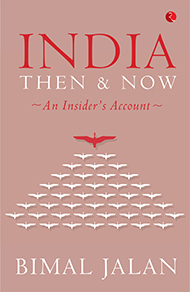IS THE PARLIAMENT BEING SILENCED? – An Excerpt from Bimal Jalan’s ‘India: Then & Now’

The Parliament of India is truly representative of the vast economic, social, regional and religious diversity of India. All income classes—from the richest industrialist to the poorest farmer—are represented. All castes and all regions find equitable representation depending on their size, population and electoral popularity. Members belong to different religions and can openly and freely espouse their beliefs, irrespective of their numbers. In the midst of this great diversity, there is also unity. Every member has a single vote and an equal right to intervene in the debate independently or on behalf of a party. The time and space allotted to party or non-party members is also equitably distributed depending on their numbers. Ministers speak on behalf of the government, but have no special privileges or ostentatious perquisites or attendants inside the House. Any member is free to interrupt, shout or otherwise disrupt the proceedings of the House, irrespective of seniority, and is subject only to the directions of the Chair inside the House. There is discussion and debate on important matters raised by the members and there may be strong political differences among the parties within and outside the government, but as it happens, most legislative proposals and official resolutions are normally adopted without dissent.
While all this is true, over the years, there has been a subtle change in the role of the Parliament below the surface, which is not evident at first glance. All the citizens who follow the news in the media or who watch parliamentary proceedings are aware of, and perhaps disappointed with, frequent disruptions that now occur in the two Houses. The concern with the functioning of India’s Parliament and state legislatures was also voiced by the National Commission to Review the working of the Constitution (2002):
If there is a sense of unease with the way the Parliament and the State legislatures are functioning, it may be due to a decline in recent years in both the quantity and quality of work done by them. Over the years the number of days on which the houses sit to transact legislative and other business has come down very significantly. Even the relatively fewer days on which the houses meet are often marked by unseemly incidents, including use of force to intimidate opponents, shouting and shutting out of debate and discussion resulting in frequent adjournments. There is increasing concern about the decline of Parliament’s falling standards of debate, erosion of the moral authority and prestige of the supreme tribune of the people.
The diminishing role of the Parliament in the conduct of national affairs is actually broader than what has been highlighted by the Commission. In recent years, there is increasing acceptance by political leaders of the frequent violation of democratic norms and conventions in the political decision-making process. As a result, there is a possible threat to the preservation of the cherished goals of ‘Unity in Diversity’, which was an important gift to the nation from leaders like Mahatma Gandhi and Nehru in the early years of independent India. Some signs of the increasing divide in the national mainstream have been evident. In 2006, as many as 160 districts of India were under the influence of Naxalites and functioned largely outside the control of state governments. As the then prime minister observed during the meeting of chief ministers on Naxalism:
Naxalism is the single biggest internal security challenge ever faced by our country… …the movement has gained in strength and now spread to over 160 districts all over the country… …the extremists are trying to establish ‘liberation zones’ in core areas where they are dispensing basic state functions of administration, policing and justice.
To what extent the growing power of militant movements reflect the weakness of the State is a moot question. It is a fact that in several states where lawlessness has spread in a large number of districts, administration has been extremely weak. Political leadership has been ineffective and there have been frequent and arbitrary transfers of senior police officers and other district officials. The duality of India is also evident in the increasing income disparities among the people—the vast contrast between India’s rising global economic position, as reflected in the large number of Indians in the list of world’s billionaires, and the deteriorating conditions in its rural areas, where more than 70 per cent of its citizens live. This divide is also reflected in the divisiveness at the highest levels of government, where ministers and leaders belonging to different parties are inclined to follow their own agenda rather than a collective and shared vision for the nation’s future.
****
Read the book on Kindle today.

